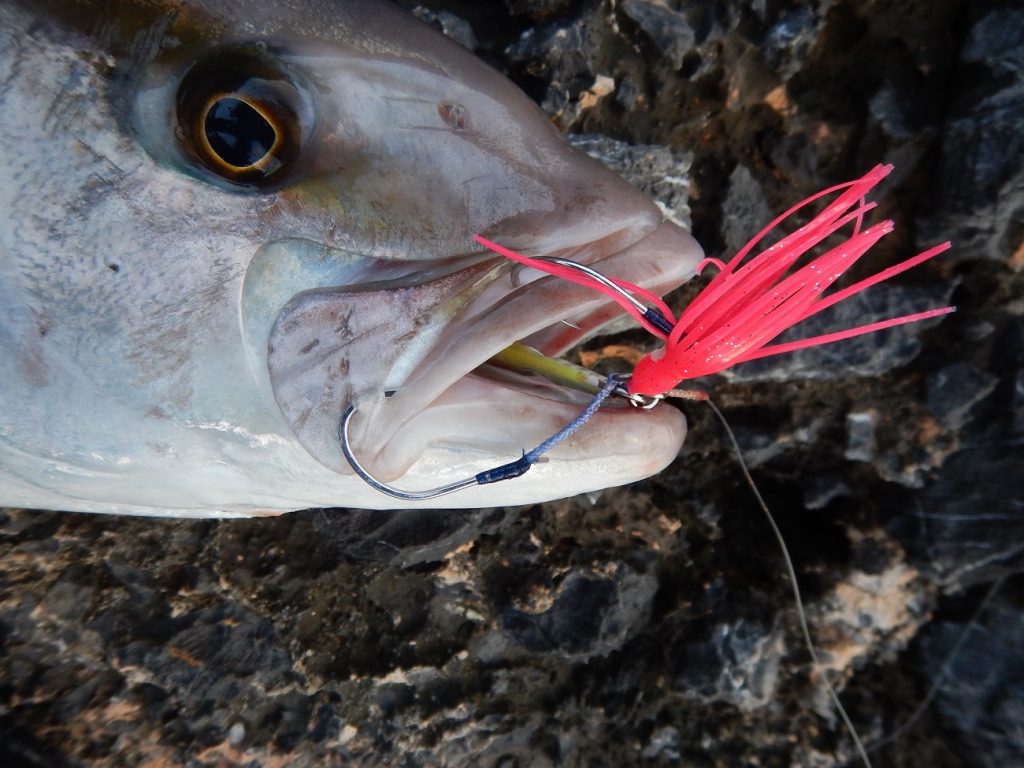Shore jigging: Silicon Octopus on the assist hooks! Right or wrong?

Double Vanfook Jigen assist hooks, one dressed and one not!
As many of you have seen already, I use very often small octopus to dress up my assist hooks. This is a good strategy for fish that are not very active, because the “movie” that they see, is that a small fish is hunting or fighting with a small octopus. Underwater, big predators always try to take advantage of anything possible in order to fill up their stomach and a small fish that does not pay attention around and try to eat another creature, is by itself an easy target. Also the silicon octopus gives some more movement effect to the whole “package”. So by far you might already think “Hey, I should have always a small octopus covering my assist hook”. No, this is definitely not the solution. And this article is exactly written to make you understand when it is better to use the small silicon octopus, and show you the advantages and disadvantages it has. Let’s start with the advantages:

1) As said before, the greatest advantage is the fight between a small cephalopod and a fish, this strategy mimics. This looks like a big opportunity for a fish to attack the careless victim and why not, to eat two items in one attack! So this is by itself the biggest advantage.
2) Silicon octopus gives extra color to our jig. Since they are produced in a huge number of colors, we have the opportunity to use any color we want. For example on silver – nickel colored jig, a pink or orange octopus, makes a hell of a contrast, irritating big predators that are known sometimes to attack because of colors.
3) The silicon octopus gives another dimension of movement. Flexible movement. The jig is 100% solid and works by the resistance of the water, producing flashes and vibrations. The soft silicon octopus adds to those two characteristics another one, the soft move of the elastic material.
4) There is another great advantage that the silicon octopus gives to our jig, and by this, we manage to get fish that normally we would never get. Some smaller fish are very compatible like small pagrus and all smaller snapper species. For them the octopus is the prime target and they attack to steal it from our jig that in their eyes is just an opponent. So we manage to catch smaller but decent fish than would never attack a “naked” assist hook.
5) Another nice aspect about silicon octopus is that they protect the jig’s finish against the continuous hit of the assist while jigging. The Octopus covers more metallic surface on the hook and protects during jigging the fragile finish of some jigs.

Yes I know I have persuade you to always use a silicon octopus. Right? Well here are some negative things you should think about very good, before you decide to always use silicon dress to your jigs.
1) Silicon Octopus often destroys the right action of middle weighted jigs. This happens because they act exactly like the feathers on the arrow, so they do not allow the jig to fall properly. The resistance they make always makes the jig to fall from one side and terminate the rolling action, or at least limit it to the less possible. Some fish like amberjacks, love more a strong rolling move rather than the entire silicon octopus in the world. So you have the first and bigger disadvantage. The negative affect of jig’s normal action.
2) Silicon octopus limit the casting distance. Yes they do! Because of the extra mass and the soft material, they tend to vibrate during flight and add resistance to the jig. This limits the final casting distance and things get even worst with wind.
3) The silicon octopus makes the movement of the assist hook twice or even slower, causing us many times a failed strike. I have said how important is the fast reaction of the assist hook when we jig and the octopus is the best way to make it as slow as possible. This causes as I said, a more slow reaction and a less efficient inhale when the fish strikes.
4) In the case we want to use two assist hooks, one dressed and one naked, then sometimes the tentacles of the soft silicon octopus, tangle with the other assist hook and this makes a mess that for sure is inefficient for a good hook up. Also in the case of one assist hook dressed, sometimes the tentacles during jigging tangle with the solid ring or the split ring above it, taking out the assist hook from use.
Hmmm now you started to think better if it is wise to use it or not ha? Well let me tell you what I normally do. When I target for bottom species like snappers or groupers, then for sure I use it since those fish really like it. Also I prefer to use it more with front and back weighted jigs that it has only little negative effect on their movement and their casting. If decide to use them, then try to use a good Japanese brand like Yamashita etc or else just be sure you use a very soft silicon octopus. I can assure you that the harder and less flexible the octopus is, the less effective it is also. So use the best quality or don’t use it at all…










